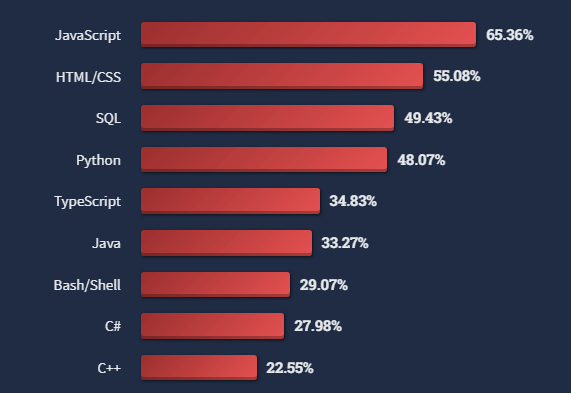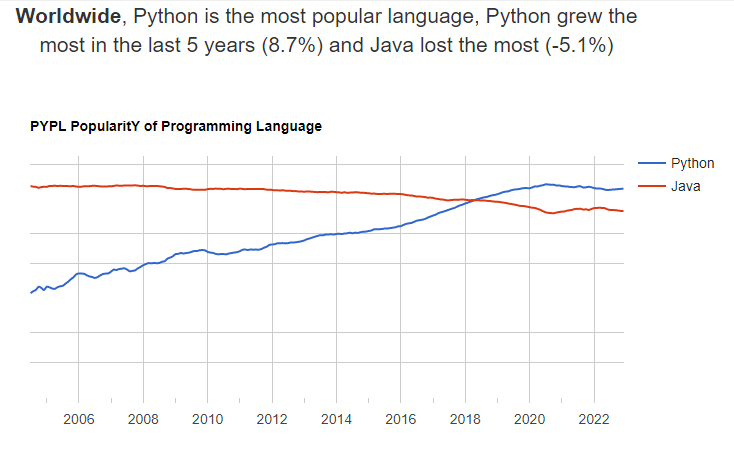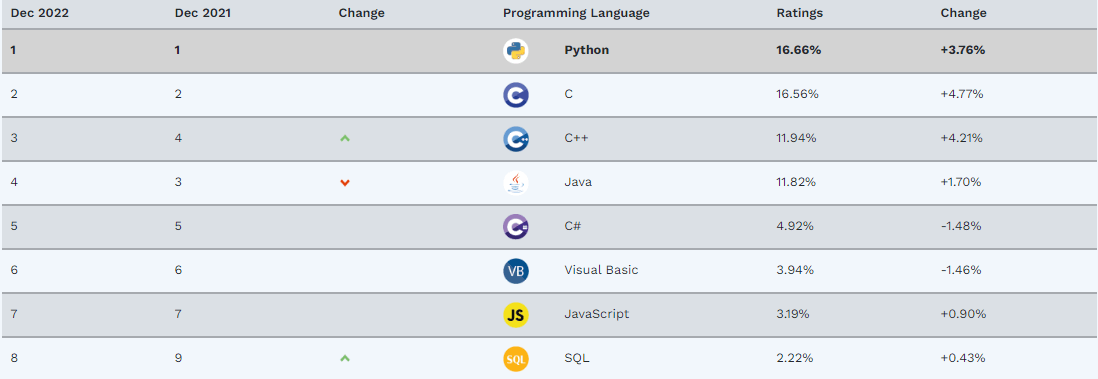Quick Summary: Python vs JavaScript are two of the most popular programming languages today. Developers use both languages to create websites, apps, and software. Although they have many similarities, Python and JavaScript are quite different in terms of their syntax, capabilities, and applications. Python is a powerful language with a simple syntax, while JavaScript is more flexible and provides more features. Depending on the project, one language may be more suitable.
The software development industry is blatantly unpredictable and dynamic. If you have at least a few years of experience in this field, I’m confident that you are aware of the flood of changes that impact the choices made by corporate executives and developers. While some technological innovations hit the market and quickly became popular, others have existed in obscurity. Therefore, before you begin working on a project, you must select one with high demand, widespread popularity, and broad use cases.
Python vs JavaScript: An Overview
Python is a general-purpose programming language widely used for scientific computing, data analysis, artificial intelligence, and backend web development. It has a simple and easy-to-learn syntax and is dynamically typed, which means that you don’t need to specify the data type of a variable when you declare it. On the other hand, JavaScript is a programming language mainly used for front-end web development, game development, and mobile app development. It is loosely typed, meaning that you don’t need to specify the data type of a variable when you declare it, but you may encounter runtime errors that would not occur in a strongly-typed language. Both Python and JavaScript are popular and widely used, but Python has a larger overall user base.
What is Python?
Python is adaptable to various programming paradigms, including imperative, procedural, functional, and object-oriented. Large built-in components and modules were generated by it. As a result, it enables programmers to create straightforward and complicated applications using a variety of programming languages.
Key Features of Python
Python is easy to learn and dynamic language, and it is known for its robust features. Following are some of the key features of python are as follows:
- Easy to code
- Fast to develop
- All domain has multiple Libraries & Modules
- Free & Open-source
- Robust Community
- It makes complex operations simpler
- Perfect for MVP

Also Read: Python Best Practices to Follow in 2024
What is JavaScript?
An object-oriented programming language, JavaScript, is widely utilized in browsers to provide dynamic functions that are impossible with standard HTML and CSS. In addition, it offers regular expression, text, and data capabilities for common applications.
Key Features of JavaScript
One of the most widely used languages, JavaScript has a wide range of features for web development. Several of JavaScript’s main characteristics are listed here.
- Presents dynamic components for websites
- An object-oriented scripting language
- Facilitates DOM manipulation
- Works on the client and the server sides
- Controls the browser

Now that you clearly understand Python and JavaScript let’s understand the difference between them, first in the tabular form and then in a more detailed understanding.
JavaScript vs Python: Tabular Comparison
This section sheds light on the differences in the tabular comparison of both JavaScript vs Python.
| Factors | Python | JavaScript |
| Hash Tables | helps create essential value pairs using hash tables by using dictionaries and sets. | creates hash tables but does not natively provide hashing functions |
| Properties & Attributes | defines attributes using the descriptor protocol. | The underlying characteristics of objects can be supported. |
| Code Blocks | uses indentation to define code chunks and sublevel components. | Defines code blocks using the character “{}” and a statement terminator. |
| Encoding Format | Default ASCII | UTF-16 |
| Functional Argument’s | Python throws an exception if a called function’s arguments are insufficient. | The default arguments in JavaScript are undefined. |
| REPL | Has in-built read-eval-print-loop | REPL using contemporary browser consoles or NodeJS |
| Annotations | lacks any semantics for annotations | coding doesn’t require annotations |
| Parameters | able to provide a function with data or arguments | Not in favor of parameterized functions. |
| Procedural Programming | Strong Support is Available | less durable than Python |
Python vs JavaScript: Head-to-Head Comparison
It would help if you kept in mind that these two of the best programming languages need not necessarily replace one another before we continue to analyze the differences between Python and JavaScript. Using these two programming language will allow you to leverage the advantages offered by both. For example, by combining Python on the server and JavaScript on the client, Instagram can handle massive traffic. However, as our goal is to identify one of them as the clear winner, we have delved into their universes and presented a set of criteria for comparison and contrast. The following are the main considerations that you need to make:
Looking to Hire Dedicated JavaScript Developers?
Trust offshore JavaScript developers from Aglowid to develop robust web and mobile apps that can accelerate your growth.
Python vs JavaScript: Performance
Regarding JavaScript vs Python speed, Python is a great choice for CPU-intensive tasks. On the other hand, JavaScript is more suitable for dynamic and real-time interactions. Inventing JavaScript was to make it fast on the web with improved user engagement. Hence, it’s moderately faster due to the multithreading feature of Node.js, which Python lacks. On the flip side, Python is the best solution for processing huge data files, CPU-intensive projects, and large-scale applications. You can Hire Python Developers who has experience in optimizing the Python code with Cython or NumPy, it will also result in enhanced performance.
JavaScript vs Python: Popularity
The popularity criterion between Python and JavaScript for web development has been changing its form as both these languages have been winning users’ hearts for their unique strengths. But if we must be more precise, Python has recently been taking the edge.
According to the Stack Overflow Developer Survey 2022, JavaScript has been voted the most commonly used technology for the tenth time in a row.

However, as various studies have shown, the world of Python app development has recently turned its head. According to the PYPL popularity of programming language index. Python has ranked in 1st position with 28.34% of the share and pushed JavaScript to 3rd with 9.28% of the share.

And according to the TIOBE programming community Index 2022, Python has secured the first position with 16.66% ratings, beating JavaScript, C, and Java for the first position.

With this, now you must be sure about the javascript vs python benchmark set for performance. So now, let’s move on to another difference.
Python vs JavaScript: Syntax
Let us look at a code snippet written in JavaScript and the same code written in Python. The code is the snippet that prints a range of values using FOR loop.
Python Code
aglowid = ['Python', 'Javascript', 'PHP']
for i in range(len(aglowid)):
print(aglowid[i])JavaScript Code
Const list = ['apple', 'banana', 'orange'];
for (let i = 0; i < list.length; i++) {
console.log(list[i]);
}JavaScript vs Python: Jobs
There are many career chances for both Python and JavaScript. On Indeed, there are currently more than 113,415 opportunities for Python and more than 113,697 positions for JavaScript. Python employment opportunities range from entry-level software engineering, and quality assurance positions to more specialized Machine Learning and Data Science careers. Several junior front-end developer positions and more senior positions for architecture and full-stack engineers are available in JavaScript. Each of these languages provides a lot of employment options.
Javascript vs Python Salary
It is challenging to directly compare the incomes of developers who use various programming languages because several variables, such as a programmer’s level of expertise, the business they engage in, and the nation they reside in, might impact their pay. However, the following broad patterns might be useful:
It stands to reason that there will likely be more employment prospects for JavaScript developers as JavaScript is generally a more well-liked programming language than Python. JavaScript programmers might thus experience increased demand and possibly increased pay.
JavaScript developers make an average yearly pay of $78,906 in the United States, whereas Python developers make an average yearly salary of $92,046. This information comes from Glassdoor. The sample sizes and other variables may differ. Thus it’s crucial to remember that these numbers might not be directly comparable.
Depending on the nation they work in, developers of JavaScript and Python might earn a wide range of incomes. JavaScript developers in India, for instance, make an average pay of $17,977 per year, whereas Python developers make an average compensation of $21,346 per year, according to statistics from Payscale. In contrast, Python developers in Switzerland make an average pay of $96,732 per year, while JavaScript developers make an average compensation of $104,441 per year.
Note: Both Python and JavaScript engineers’ typical salaries have been covered. However, it’s important to remember that both programming languages have many work professions available. Therefore salaries may differ depending on the particular profession.
Python vs JavaScript: Numeric Types
Between Python vs javascript for web development In contrast to JavaScript, which only supports floating-point variables, Python offers a wide range of numeric data types. For example, data recorded in a database column as a numeric value without any accompanying text is known as a numeric data type. Numerical types stand apart from other forms of data because they can be calculated mathematically and statistically. Current V8 engines and clients also enable a new basic type, even if JavaScript only has a small number of variables. But Python also has a variety of numeric data variables, including floating, defined decimal, and int.
JavaScript vs Python: Implicit Conversion
Python is a strongly-typed programming language, while JavaScript is weakly-typed in terms of implicit conversion.
In other words, Python doesn’t perform implicit data type conversion. It does, nonetheless, support both strong and dynamic typing. As for JavaScript, it is weakly typed since it offers implicit data type conversion.
The type conversion in JavaScript, for instance, will take place as follows:
3 + "3"; /The result is the string "33."
However, a TypeError will result if you attempt the same thing in Python. The ability of a variable to change its type in response to its allocation anywhere in a specified category is known as dynamic typing.
Javascript vs Python: which is easier?
This question is particularly crucial if you’re studying a computer language for the initial time and have no prior coding expertise. It will help if you choose a language that is easier to learn and has a shortened learning curve. Python performs far better than JavaScript on this metric. It employs basic variables and functions and is created to be as relatively novice as feasible. Class definitions are just one of the many complicated aspects of JavaScript. Python is the undisputed champion in terms of learning simplicity.
Also Read: Top Javascript Frameworks in 2024
Python vs JavaScript: Which Should You Use?
In the end, the choice between Python and JavaScript will come down to your project’s precise objectives and specifications, as well as your tastes and level of programming expertise. The ideal option for your project will rely on your particular demands and objectives because both languages have distinctive strengths and drawbacks.
Wrapping Up!
In summary, Python and JavaScript are well-liked programming languages frequently employed for a wide range of jobs. JavaScript is well known for its versatility and capacity to work natively in web browsers, but Python is well known for its simplicity, adaptability, and excellent support for scientific computing. Which language is best ultimately depends on the particular requirements of the project at hand. For example, Python may be a better option if you require a language that has easy learning and seamless user experience, has a significant and engaged community, and is suitable for machine learning and data analysis. On the other hand, JavaScript can be the best option if you require a language that is simple to learn and use, has a huge and dynamic community, and is suitable for creating online apps.
have a unique app Idea?
Hire Certified Developers To Build Robust Feature, Rich App And Websites





 Say
Say